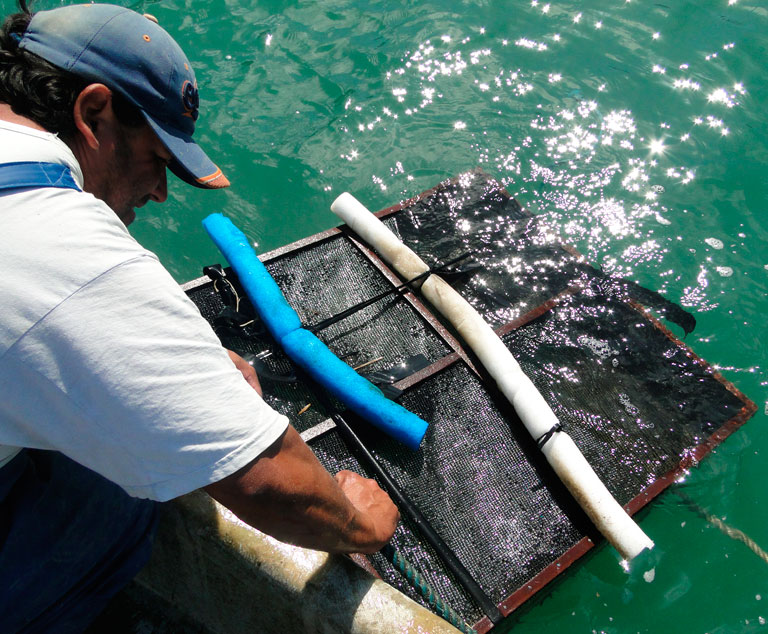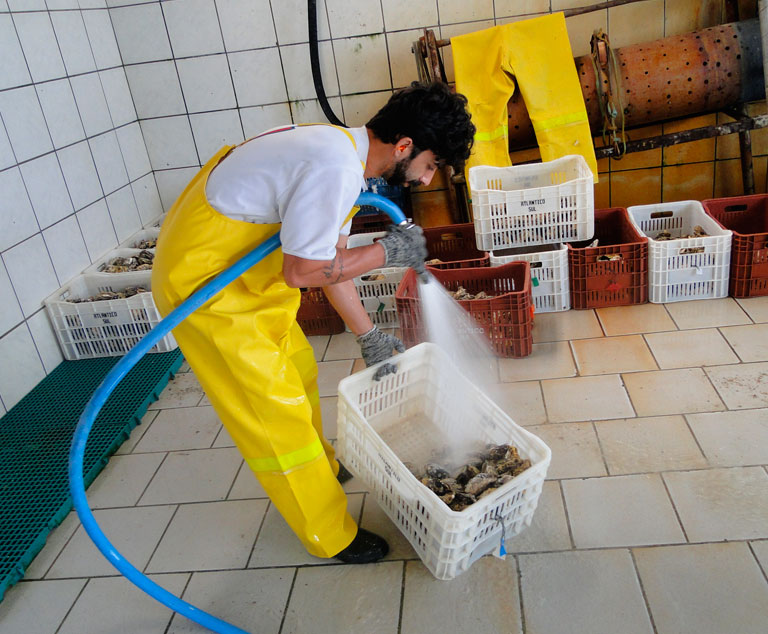Typical of Santa Catarina, shellfishes for first time in Census of Agriculture
January 22, 2018 09h00 AM | Last Updated: June 05, 2018 03h49 PM
Shellfish growing and poultry farming are among the most important economic activities in Santa Catarina. The national production of oysters, mussels and scallops comes almost exclusively from the Santa Catarina coast. According to the IBGE´s Municipal Livestock Production - PPM, 20,828 tonnes were produced in 2016, which accounts for 97.9% of the Brazilian malacological culture. Adding up to 140 million head, the herd of poultry is the third highest in Brazil, just after Paraná and São Paulo.
Included for the first time in the Census of Agriculture, the survey on the production of shellfishes – or malacological culture – required specific guidelines as, for example, at which point of the marine farm should the data be collected. "As the crop area is in the sea, it was established that the questionnaires should be answered at the point of landing of the production", tells Caio Andrade, agronomist and census analyst.
The register of marine farms is another important point that is being raised by the Census of Agriculture. The areas for shellfish growing are 20-year concessions from the Union to the marine farmers, who, in return, pay a rate to the federal administration.
The Santa Catarina State Agricultural Research and Rural Extension Agency - Epagri is in charge of the state statistics of this sector. Related to 2016, the most recent data point out that shellfish growing is carried out by 604 marine farmers in 12 municipalities of the Santa Catarina coast. Most marine farms are located in the south and north bays of the Santa Catarina Island: in Florianópolis, the largest national producer of oysters, and in Palhoça, the largest producer of mussels – or shellfishes, as they are called in that region. Mainly grown in Penha, in the north coast, scallops are quite less produced (27 tonnes in 2016) than oysters and mussels (2,280 tonnes and 12,534 tonnes, respectively, in this period).
According to Epagri, Santa Catarina lives a decade of stagnation. The output in 2016 was the smallest one since 2009. It dropped 24.74% in relation to 2015. A total of 2,185 persons were directly involved in the production chain, a reduction of 5.62% over 2015, when this sector counted on 2,315 workers. The lack of public policies is the major problem pointed out by Epagri. Marine farmer for 22 years, Nelson Silveira Junior not only agrees but rises the tone of the criticism when talking about public managers in this sector: "too narrow-minded, very bad for the marine culture". He runs one of the largest marine farms in Florianópolis, and one of the first marine farmers interviewed by the Census of Agriculture. " I can´t criticize without contributing. The Census is important to provide figures to the government and to point out the problems of the production chain", says the 57-year producer.






Poultry industry: small properties integrated to production chain
Home of major brands in this sector, Santa Catarina´s chicken meat is its main export product. While slaughter and processing are industrial activities, poultry farming depends for decades on thousands of small and medium rural establishments integrated with the production chain of large slaughterhouses.
In Concórdia, in the west of Santa Catarina, it is hard to find a rural property without aviaries. "The number of aviaries per property varies. Enterprises are now making four or five per property. But is is usually one or two in the old ones", says William Finger Azevedo, an IBGE enumerator that closed the data collection last week, completing four enumeration areas in Concórdia and one in the neighbor municipality of Presidente Castelo Branco.
The 19-year youngster lives with his parents, farmers in Linha Barra do Tigre, interior of Concórdia. William used a motorcycle to visit the establishments. "Roads are not too bad, only the weather is pretty much unstable. What satisfies us is that we are being welcomed. They ask us to step inside, offering water, food, mate", said him in the first time he talked with the reporter in the end of October. Looked for again last Thursday, William assured that the work as an enumerator "was worthwhile".

In Faxinal dos Guedes, another municipality in the west of Santa Catarina, the fieldwork is also already closed. In the beginning of the data collection, enumerator Remi Telles, 33 years old, used a local radio to disseminate the Census of Agriculture, leaving his name and telephone to clear eventual doubts from the producers. "Many of them are already expecting me and, when they find me, they ask when I will visit them", stated him at the time, adding that the fact that he was born in Faxinal left the producers "more relaxed when they knew that I was the enumerator".
According to Remi, drinking mate was usual when answering the questionnaire. Depending on the moment of the visit, the hospitality was even greater. On one occasion, the producer was preparing a barbecue. "He hosted me and said: 'before talking, let´s eat some barbecue'", recalled Remi. On January 12, he closed the last of the four enumeration areas assigned to him. He now expects a new opportunity in another city: "they asked me to wait to check for another position".
There are aviaries of different sizes. According to William, most of the aviaries in Concórdia are 100 meters long by 10 to 12 meters wide, with a capacity of about 12 thousand poultry. The fattening period takes about five weeks. After that, from eight to 12 days are needed for cleaning and sanitization. Therefore, it is a two-month cycle. "It demands a few workforce, almost everything is automated. Most of the poultry farmers that I visited had another income, either from dairy cattle or crops. They are senior people, working with their children", explains him.
According to Laudete Maria Sartoretto, teacher and coordinator of the Agronomics course at the Concórdia College - FACC, the poultry industry survived the changes in the countryside mainly because it requires few workforce. "The families are smaller today, with three children at most and not all of them willing to remain in the countryside. Automating everything and requiring less workforce make easier for small and medium producers to maintain the poultry activity", says her.


















